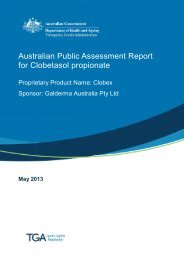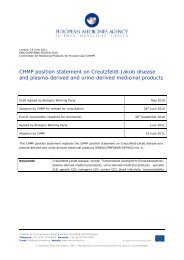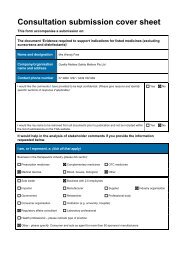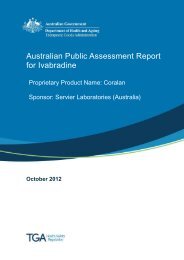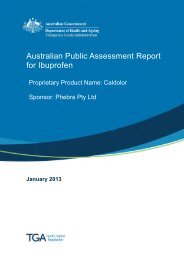AusPAR: Cabazitaxel - Therapeutic Goods Administration
AusPAR: Cabazitaxel - Therapeutic Goods Administration
AusPAR: Cabazitaxel - Therapeutic Goods Administration
Create successful ePaper yourself
Turn your PDF publications into a flip-book with our unique Google optimized e-Paper software.
<strong>AusPAR</strong> Jevtana <strong>Cabazitaxel</strong> Sanofi-Aventis Australia Pty Ltd PM-2010-02565-3-4<br />
Final 9 February 2012<br />
<strong>Therapeutic</strong> <strong>Goods</strong> <strong>Administration</strong><br />
patients, however, were selected on the basis that they tolerated cabazitaxel well in the<br />
first cycle.<br />
The 25 mg/m 2 dose was chosen for the pivotal study (EFC 6193) to provide optimal dose<br />
intensity and potentially increase clinical benefit.<br />
Pivotal efficacy study<br />
The pivotal efficacy study was study EFC 6193 which was a randomized, open label,<br />
multicentre study of cabazitaxel at 25 mg/m2 in combination with prednisone every 3<br />
weeks, compared with mitoxantrone in combination with prednisone for the treatment of<br />
hormone refractory metastatic prostate cancer previously treated with a docetaxel<br />
(Taxotere) containing regimen.<br />
Study design, objectives, locations and dates<br />
This randomised open label study was conducted in 26 countries (Argentina, Belgium,<br />
Brazil, Canada, Chile, Czech Republic, Denmark, Finland, France, Germany, Hungary, India,<br />
Italy, Korea, Mexico, Netherlands, Russia, Singapore, Slovakia, South Africa, Spain, Sweden,<br />
Taiwan, Turkey, UK and USA).<br />
The first patient was enrolled on 2 January 2007. The last patient completed the study<br />
(data cut-off date) on 25 September 2009. Patients were randomized (1:1) after screening<br />
(Figure 1). The screening process included medical history, physical examination, ECOG<br />
performance status, prior treatments, blood counts, serum biochemistries, serum<br />
testosterone, left ventricular ejection fraction (LVEF), electrocardiogram (ECG), prostate<br />
specific antigen (PSA) level, bone scan, radiological tumour measurements, pain<br />
assessment (present pain intensity [PPI] score) and analgesic use. 19 These assessments<br />
were repeated at the beginning and end of each cycle. Laboratory tests, including LVEF,<br />
bone scan and radiological tumour measurements were repeated at every even numbered<br />
cycle and finally performed at the end of treatment or at study withdrawal.<br />
19 ECOG Performance Status. The Eastern Cooperative Oncology Group (ECOG) has developed criteria<br />
used by doctors and researchers to assess how a patient's disease is progressing, assess how the<br />
disease affects the daily living abilities of the patient, and determine appropriate treatment and<br />
prognosis. The following are used:<br />
0 - Fully active, able to carry on all pre-disease performance without restriction<br />
1- Restricted in physically strenuous activity but ambulatory and able to carry out work of a light or<br />
sedentary nature, e.g., light house work, office work<br />
2 - Ambulatory and capable of all selfcare but unable to carry out any work activities. Up and about<br />
more than 50% of waking hours<br />
3 - Capable of only limited selfcare, confined to bed or chair more than 50% of waking hours<br />
4 - Completely disabled. Cannot carry on any selfcare. Totally confined to bed or chair<br />
5 – Dead<br />
Page 28 of 75





